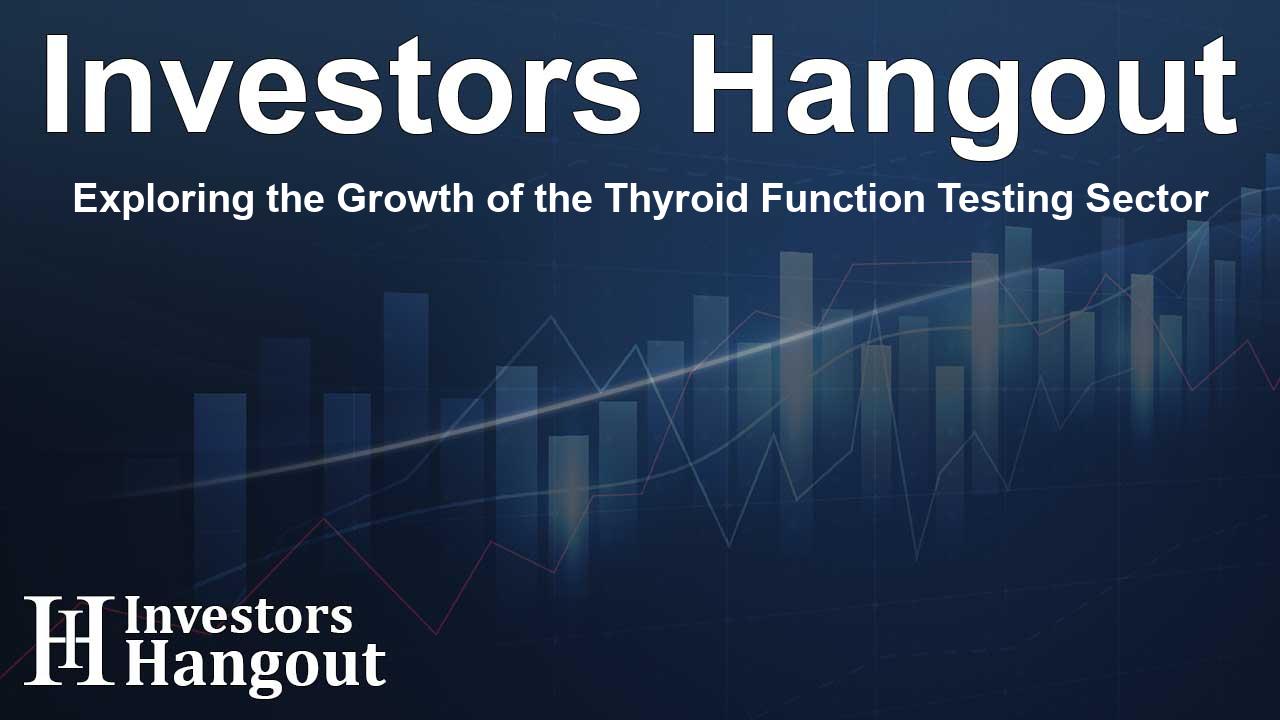Exploring the Growth of the Thyroid Function Testing Sector

Thyroid Function Testing Market Overview
The thyroid function testing market is experiencing dynamic growth, projected to reach USD 2.74 billion by 2032. This upward trajectory is driven by the increasing prevalence of thyroid disorders and significant advancements in technology. With the current market valued at USD 1.68 billion as of 2023, a compound annual growth rate (CAGR) of 5.58% is expected in the coming years.
Driving Factors Behind Market Growth
The rise in global cases of thyroid diseases, including hypothyroidism and hyperthyroidism, is a major contributor to the demand for thyroid tests. Furthermore, as populations age, the incidence of these disorders has increased, prompting greater awareness and diagnostic initiatives. Government campaigns aimed at promoting thyroid health education have increased the emphasis on routine testing, benefitting the market.
U.S. Market Dynamics
In the United States alone, the thyroid testing market is projected to grow from USD 0.50 billion in 2023 to USD 0.79 billion by 2032. This growth is bolstered by extensive screening programs and an alarming rate of misdiagnosis; the American Thyroid Association estimates that 60% of Americans with thyroid disorders remain undiagnosed. This statistic highlights a significant opportunity for laboratories to enhance the reliability and speed of thyroid diagnostics through advancements such as chemiluminescence immunoassays (CLIA) and point-of-care testing options.
Importance of Key Players
A diverse range of companies is active in the thyroid function testing market, each contributing unique diagnostic solutions. Companies such as Abbott Laboratories, Siemens Healthineers, and Roche Diagnostics are instrumental in developing the tests that hospitals and diagnostic centers rely upon. Each firm offers specialized assays suited for various clinical needs, facilitating accurate diagnoses and timely patient care.
Market Segmentation Insights
The thyroid function testing market can be divided into segments based on test types and end-user categories. The TSH (Thyroid-Stimulating Hormone) test currently commands the largest market share, accounting for over 42% of the total segment. Its role in screening and monitoring thyroid disorders has made it a trusted option in clinical settings. Additionally, the Free T4 test is emerging rapidly among clinicians seeking precise diagnostics offerings.
Impacts of Hospitals and Diagnostic Laboratories
In 2023, hospitals were the leading providers for thyroid testing, capturing nearly 38.5% of the market. Their comprehensive testing capabilities, along with advanced laboratory infrastructure, support efficient diagnosis and treatment protocols. Notably, diagnostic laboratories are emerging as strong contenders in this environment, driven by the outsourcing trend for cost-effective and accurate testing solutions.
Regional Demand Analysis
Geographically, North America leads the thyroid function testing market, holding over 43% of the global market share. Factors such as high disease awareness and collaborative health initiatives play a significant role in this dominance. Meanwhile, the Asia Pacific region is expected to see the fastest growth, propelled by burgeoning healthcare investments and a rising emphasis on preventive health measures, particularly in fast-developing nations like India and China.
Recent Developments and Innovations
Innovations in the market are paving the way for improved thyroid function testing methods. For instance, the introduction of microvolume testing devices, like Siemens Healthcare's Atellica CI Analyzer, illustrates how technology can enhance testing efficiency and accuracy, especially in critical care pediatrics.
Future Prospects and Statistical Trends
The thyroid function testing market is on track for significant expansion. With about 200 million individuals globally affected by thyroid disorders, the demand for thorough and reliable testing is expected to rise. As healthcare advances and screening becomes more accessible, the annual volume of tests is anticipated to exceed 1.1 billion by 2032. This trend reflects not only increased diagnosis and management of thyroid conditions but also a shift towards more preventive healthcare practices.
Frequently Asked Questions
What is the projected market value for thyroid function testing by 2032?
It is projected to reach USD 2.74 billion by 2032.
Which test type currently holds the largest share in the market?
The TSH test dominates the market, responsible for over 42% of the segment share.
What factors are driving the growth of this market?
The rising prevalence of thyroid disorders and advancements in diagnostic technology are major drivers.
Which region is expected to see the fastest growth in this market?
The Asia Pacific region is anticipated to grow the fastest due to increased healthcare investments.
How many people are estimated to suffer from thyroid disorders globally?
Approximately 200 million people live with some form of thyroid disorder worldwide.
About The Author
Contact Dylan Bailey privately here. Or send an email with ATTN: Dylan Bailey as the subject to contact@investorshangout.com.
About Investors Hangout
Investors Hangout is a leading online stock forum for financial discussion and learning, offering a wide range of free tools and resources. It draws in traders of all levels, who exchange market knowledge, investigate trading tactics, and keep an eye on industry developments in real time. Featuring financial articles, stock message boards, quotes, charts, company profiles, and live news updates. Through cooperative learning and a wealth of informational resources, it helps users from novices creating their first portfolios to experts honing their techniques. Join Investors Hangout today: https://investorshangout.com/
The content of this article is based on factual, publicly available information and does not represent legal, financial, or investment advice. Investors Hangout does not offer financial advice, and the author is not a licensed financial advisor. Consult a qualified advisor before making any financial or investment decisions based on this article. This article should not be considered advice to purchase, sell, or hold any securities or other investments. If any of the material provided here is inaccurate, please contact us for corrections.
